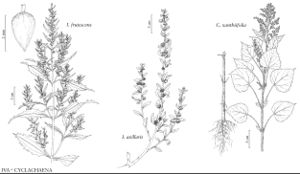Iva
Sp. Pl. 2: 988. 1753.
Gen. Pl. ed. 5, 426. 1754.
| Taxon | Illustrator ⠉ | |
|---|---|---|
 | Iva frutescens Iva axillaris Cyclachaena xanthiifolia | Yevonn Wilson-Ramsey Yevonn Wilson-Ramsey Marjorie C. Leggitt |
Annuals, perennials, subshrubs, or shrubs, 10–350 cm. Stems usually erect, sometimes decumbent to sprawling, often freely branched. Leaves cauline; mostly opposite (distal sometimes alternate); petiolate or sessile; blades (1-nerved or 3-nerved) deltate, elliptic, filiform, lanceolate, linear, obovate, ovate, spatulate, or trullate, margins entire or toothed, faces glabrous or ± scabrellous, often glanddotted. Heads discoid or ± disciform, in (± bracteate) racemiform or spiciform arrays (heads 1–2 in axil of each bract, bracts sometimes leaflike). Involucres ± hemispheric or turbinate to campanulate or urceolate, 2–10+ mm diam. Phyllaries persistent, 3–15+ in 1–3+ series, distinct or ± connate, all ± herbaceous or inner scarious to membranous. Receptacles flat or convex to hemispheric; paleae cuneiform or spatulate to linear or setiform, ± membranous, sometimes all or partially wanting. Pistillate florets usually 1–8+, rarely 0; corollas whitish (inconspicuous), ± tubular. Functionally staminate florets 3–20+; corollas whitish to pinkish, funnelform, lobes 5, soon reflexed (filaments ± connate, anthers coherent or distinct). Cypselae plumply obovoid to pyriform, often ± obcompressed, sometimes scabrellous or hispidulous distally, usually ± glanddotted; pappi 0. x = 18.
Distribution
Mostly temperate North America, some subtropical, some in Old World
Discussion
Species ca. 9 (7 in the flora).
M. Bolick (1983), P. O. Karis (1995), and B. Miao et al. (1995, 1995b, 1995c) considered Iva in the sense of R. C. Jackson (1960) to include species that have closer relatives outside Iva in the broad sense than within. I agree and treat the extradited species in Chorisiva, Cyclachaena, Hedosyne, Leuciva, and Oxytenia.
Ivas are wind pollinated, are related to the ragweeds (Ambrosia spp.), and may be similarly associated with pollen allergies.
Records of Iva asperifolia Lessing from Florida are evidently based on specimens that are treated as members of I. angustifolia.
Selected References
None.
Lower Taxa
Key
| 1 | Annuals (seldom persisting); leaf blades deltate, filiform, lanceolate, lance-linear, or ovate (rarely succulent or fleshy); heads in ± spiciform arrays; peduncles mostly 0.5–1 mm | > 2 |
| 1 | Perennials, subshrubs, or shrubs; leaf blades elliptic, lanceolate, oblanceolate, obovate, ovate, or spatulate (usually ± succulent or fleshy); heads in ± racemiform arrays; peduncles mostly 1–7 mm | > 4 |
| 2 | Leaves petiolate, blades mostly deltate to lanceolate, margins toothed | Iva annua |
| 2 | Leaves ± sessile, blades mostly lance-linear to filiform, margins entire | > 3 |
| 3 | Involucres ± prismatically turbinate, 2.5–3 mm; outer phyllaries ± connate | Iva angustifolia |
| 3 | Involucres ± hemispheric, 1.5–2 mm; outer phyllaries distinct | Iva microcephala |
| 4 | Subshrubs or shrubs, 50–350 cm; leaf blades ovate or elliptic to lanceolate, margins usually toothed | Iva frutescens |
| 4 | Perennials or subshrubs, 10–50(–100) cm; leaf blades mostly obovate or elliptic to lanceolate, oblanceolate, or spatulate, margins usually entire, rarely toothed | > 5 |
| 5 | Leaf blades glabrous; involucres campanulate to urceolate, 5–7+ mm; cypselae 4–5 mm | Iva imbricata |
| 5 | Leaf blades usually strigose to scabrellous; involucres ± hemispheric, 2–3.5 mm; cypselae 2–3 mm | > 6 |
| 6 | Aerial stems usually woody at bases; outer phyllaries distinct | Iva hayesiana |
| 6 | Aerial stems usually herbaceous; outer phyllaries ± connate | Iva axillaris |